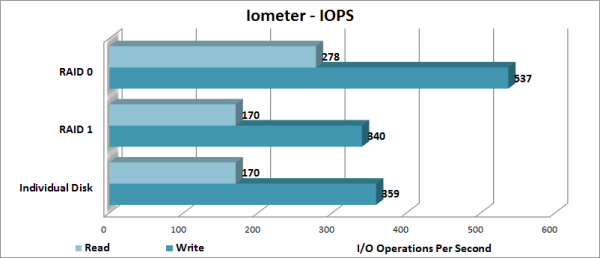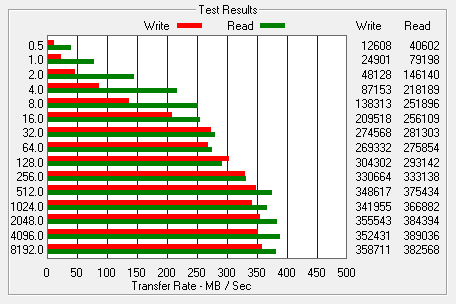To test the PEXSAT34RH's RAID performance, a pair of Seagate Barracuda 1TB (ST1000DM003) hard drives were used. The tests were first run with the drives configured as RAID 0 volume and then again as a RAID 1 volume.
CrystalDiskMark 3.0:
First, I ran a few quick tests using CrystalDiskMark. This benchmark tool measures the performance of a storage device by testing its sequential read and write speeds as well as its random read and write speeds using blocks 4KB and 512KB in size.
The two hard drives performed very well when configured as a RAID 0 volume. In our tests, they were able to read at 340.1 MB/s and write at 330.6 MB/s. The two drives weren't nearly as fast when mirrored in a RAID 1 array. As you can see, the sequential read and write speeds were slightly slower than what we saw with a single disk.
ATTO Disk Benchmark 2.46:
I also used ATTO Disk Benchmark to test the PEXSAT34RH's sequential read and write speeds when using RAID. The tests are run using blocks ranging in size from 0.5KB to 8192KB and the total length set to 32MB and 256MB.
When configured as a RAID 0 array, the two hard drives were able to read at 389 MB/s and write at 358 MB/s. The read speeds were also surprisingly good when using RAID 1. However, the write speed dropped to 184 MB/s.
Iometer:
Lastly, I ran a series of tests using Iometer. This tool can be configured to benchmark a number of things. In this case, I used it to measure the PEXSAT34RH's read and write speeds and the number of operations per second. The tests were run using random bytes and a queue depth of 3.

When configured as a RAID 0 array, the two drives were able to read at 225.09 MB/s and write at 176.36 MB/s. They were also able to read at a respectable 229.55 MB/s when in RAID 1. However, the write speed dropped to 101.71 MB/s, which is slower than what we saw with a single drive.









